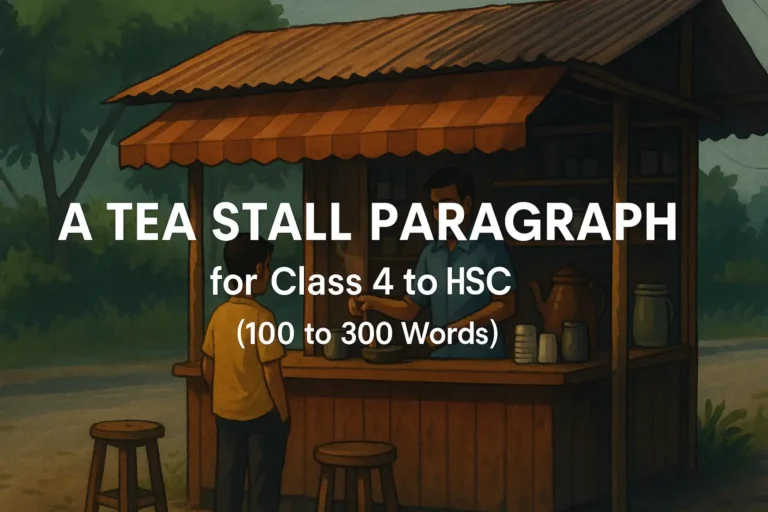Sundarban Paragraph for Class 3 to HSC
The Sundarban is one of the most important natural places in Bangladesh. Many students search for a clear and complete paragraph on it.
In this post, I’ve written different Sundarban paragraphs for classes 4 to 12. Each one is simple, informative, and helpful for exams and everyday learning.
In this paragraph, we have tried to answering/ covering this following questions:
- What is Sundarban?
- Where is it located?
- Why is it famous?
- What animals live there?
- What trees grow there?
- Why is it important?
- What problems does it face?
- How can we protect it?
Paragraph on Sundarban in 10 Lines for Class 4-5
- The Sundarban is the largest mangrove forest in the world.
- It is located in the southern part of Bangladesh, near the Bay of Bengal.
- Sundarban is famous for its Royal Bengal Tigers.
- Many animals live there, like deer, crocodiles, monkeys, and birds.
- The forest has special trees called Sundari trees.
- It helps protect us from floods and storms.
- The Sundarban is very important for our environment.
- It faces problems like deforestation and climate change.
- Pollution and illegal hunting also harm the forest.
- We must save Sundarban by planting trees and stopping pollution.
Also Read: City Life and Rural Life Paragraph
Sundarban Paragraph for Class 6-7 (150 Words)
The Sundarban is the biggest mangrove forest in the world. It is located in the southern part of Bangladesh and spreads into India. It lies where the Ganga, Brahmaputra, and Meghna rivers meet the Bay of Bengal. The name Sundarban comes from the “Sundari” tree, which grows in this forest.
Sundarban is famous for the Royal Bengal Tiger. It is also home to deer, monkeys, wild boars, crocodiles, snakes, and many birds. It has many rivers, canals, and small islands. People call it a “green shield” because it protects us from cyclones and floods.
This forest is important for animals, the environment, and local people. It gives us wood, honey, and fish. Many people work there to collect these things. It also helps control climate and save biodiversity.
But Sundarban is in danger. It faces problems like cutting trees, water pollution, and climate change. We must plant trees, keep the rivers clean, and stop illegal hunting to save it.
Also Read: Our Village Paragraph
My Visit to Sundarban Paragraph in 200 Words for Class 8
Last winter, I visited the Sundarban with my family. It was one of the best trips of my life. We went there by boat, and the journey through the rivers felt magical.
The Sundarban is the world’s largest mangrove forest. It is in the southern part of Bangladesh, near the Bay of Bengal. The forest is full of rivers, canals, and small islands.
I saw many Sundari trees, which grow only in this area. We also saw golpata, gewa, and goran trees. These trees grow well in salty water and protect the land from storms.
During our boat ride, we saw deer, monkeys, and many birds. The guide told us that the Royal Bengal Tiger lives deep inside the forest. We also learned about crocodiles, wild boars, and snakes that live there.
The forest is very important for nature. It protects us from cyclones and gives many people jobs. Fishermen and honey collectors depend on it.
But the Sundarban is in danger. People cut trees and pollute the water. Climate change is also harming the forest.
We must protect it for the future. We can do this by planting trees and following forest rules. I will never forget this amazing trip and what I learned there.
Also Read: A Winter Morning Paragraph
My Visit to Sundarban Paragraph for Class 9-10/ SSC (250 Words)
Last year, I had a chance to visit the Sundarban with my school group. It was a study tour arranged by our science teacher. We were very excited because we had read a lot about this forest in our books.
The Sundarban is the largest mangrove forest in the world. It is located in the southern part of Bangladesh and also stretches into India. This forest lies near the Bay of Bengal and is made up of many rivers, canals, and small islands.
We traveled by boat and saw the beautiful green forest all around us. The air was fresh, and the sound of birds made the place feel alive. We also saw fishermen and honey collectors working in the area.
One of the most interesting parts was learning about the Royal Bengal Tiger. Although we didn’t see one, we saw its footprints on the mud. We also saw deer, monkeys, wild boars, and many colorful birds.
The forest is full of Sundari trees, which grow well in salty water. There are also gewa, goran, and keora trees. These trees help protect the land from strong waves and wind.
The Sundarban is important for nature and people. It saves us from cyclones, provides natural resources, and is home to many rare animals. But the forest is in danger because of pollution, tree cutting, and climate change.
To protect it, we must raise awareness and follow forest rules. My visit to the Sundarban was a great learning experience that I will never forget.
Also Read: Cox’s Bazar Paragraph
Sundarban Paragraph for HSC (300 Words)
The Sundarban is the largest mangrove forest in the world. It is located in the southwest part of Bangladesh and also stretches into India. This forest lies in the delta formed by the Ganges, Brahmaputra, and Meghna rivers.
The Sundarban is famous for the Royal Bengal Tiger, which is a rare and powerful animal. Many other animals also live here, such as spotted deer, wild boars, crocodiles, monkeys, and different types of snakes. It is also home to many kinds of birds and fish.
One special thing about the Sundarban is its trees. The Sundari tree is the most common one, and the forest is named after it. Other trees like gewa, goran, and keora also grow there and can survive in salty water.
This forest is very important for both nature and people. It works like a natural wall and protects our coastal areas from cyclones, floods, and tidal surges. It also gives us wood, honey, fish, and helps many people earn their living.
But the Sundarban is facing many problems today. Trees are being cut down illegally, and pollution is harming the water and soil. Climate change is also making things worse by increasing the sea level and salinity.
We must take strong steps to protect the Sundarban. People should be educated about its value. Strict laws, proper forest management, and planting more trees can help save this unique forest.
The Sundarban is not only a part of our land, it is a part of our identity. If we fail to protect it, we will lose a great natural treasure. Every citizen should take responsibility to keep it safe for future generations.
FAQ’s on Sundarban
1. What is Sundarban?
The Sundarban is the largest mangrove forest in the world. It is a beautiful and famous natural area located in the southern part of Bangladesh.
2. Why is the Sundarban important?
It protects us from floods and storms. It also gives us fresh air, wood, honey, and many useful plants. It helps nature stay balanced.
3. Where is Sundarban located?
The Sundarban is mainly in Bangladesh, in Khulna, Satkhira, and Bagerhat districts. A part of it is also in the neighboring country, India.
4. What animals live in the Sundarban?
Many wild animals live there, like the Royal Bengal Tiger, deer, monkeys, crocodiles, snakes, and different kinds of birds and fish.
5. What is the Royal Bengal Tiger?
The Royal Bengal Tiger is a strong and beautiful tiger found in the Sundarban. It is the national animal of Bangladesh and is famous all over the world.
6. What kind of trees grow in the Sundarban?
Mainly mangrove trees grow in the Sundarban. Some common trees are Sundari, Goran, Keora, and Gewa. These trees grow well in salty water.
7. Why is Sundarban called a UNESCO World Heritage Site?
UNESCO gave this title because the Sundarban is a very special and rare forest. It has rich wildlife and helps protect the environment.
8. Can people visit the Sundarban?
Yes, people can visit the Sundarban. It is a popular tourist spot. Many people go there to see nature, wildlife, rivers, and greenery.
9. Do people live in the Sundarban
Yes, some people live near the forest. They collect honey, fish, and wood. They live simple lives and depend on the forest for their living.
10. How can we protect the Sundarban?
We can protect the Sundarban by not cutting trees, stopping pollution, and keeping animals safe. We must love and care for this great gift of nature.




